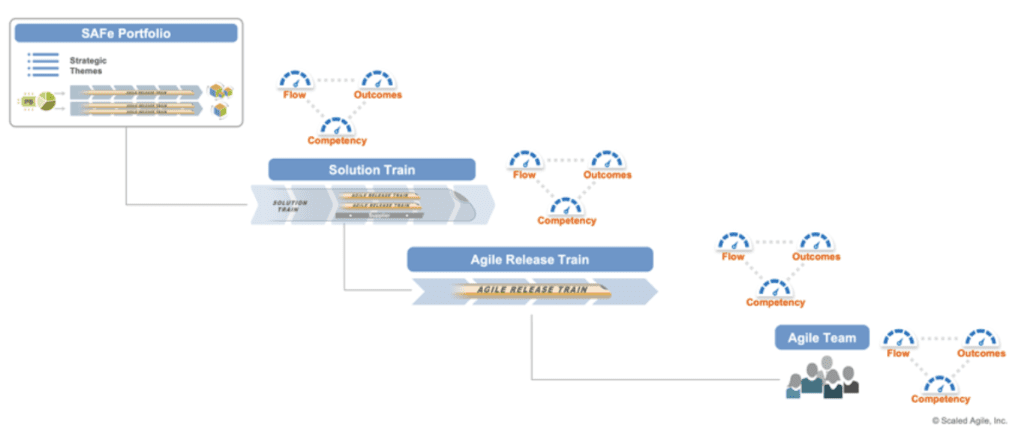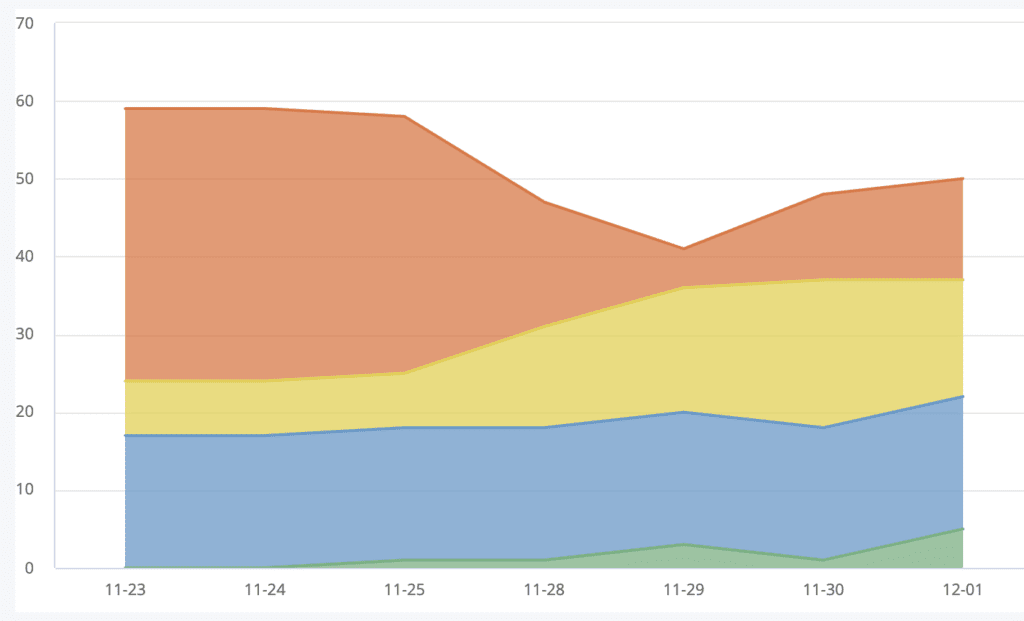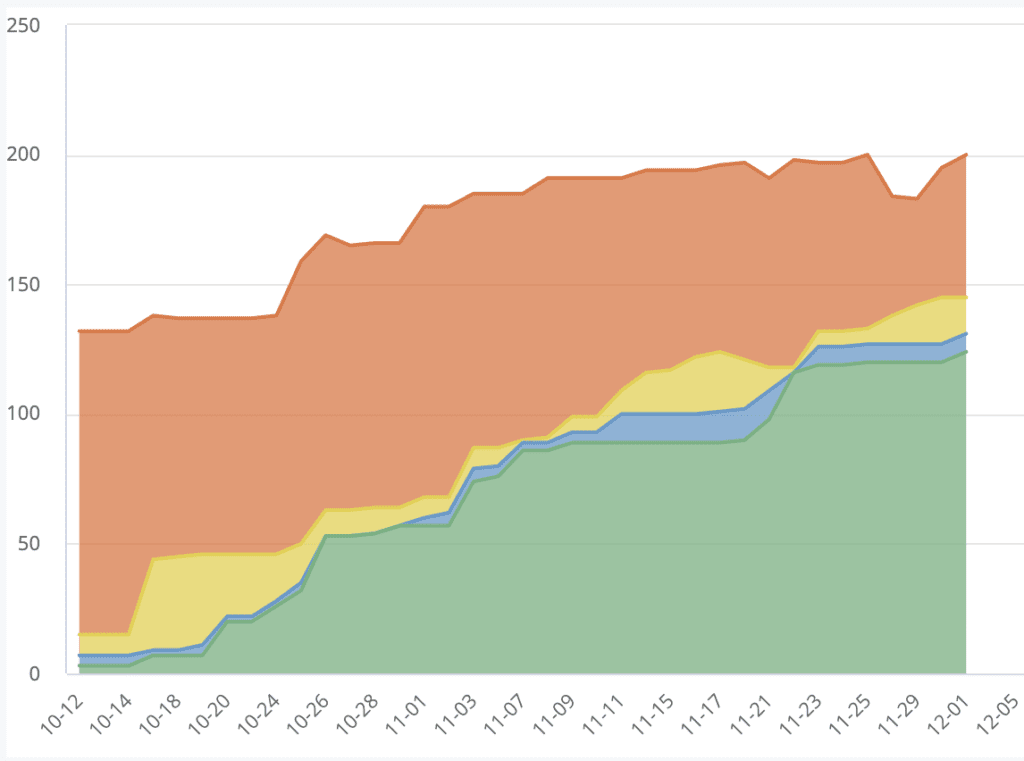
We started this series on SAFe® team metrics with the simple acknowledgment that contextualizing SAFe metrics for a non-technical Agile team can be difficult. To continue learning how other teams adapt SAFe metrics to their specific context, I sat down with Amber Lillestolen, the Scrum Master of the Corporate Communications (Comms) team at Scaled Agile, Inc. Here’s what she shared about applying SAFe metrics for a ‘traditional’ communications team.
Applying SAFe® Metrics in Marketing for a Communications Team
Scaled Agile has a few small cross-functional marketing teams to support different business areas. Corporate Comms is one of these small teams. Their purpose is to propel market growth through a cohesive, compelling brand experience that inspires delight, confidence, and loyalty in current and prospective customers.
The team works across the company—from public relations to customer stories and brand work for new product launches. Rather than debugging and deploying, communications professionals help simplify and communicate complex messaging, refine product value propositions, develop thought leadership content, and much more. This work requires significant cross-functional skill, research capabilities, collaboration, qualitative reasoning, and the ability to build alignment while planning for future releases.
Their common work items include
- Company-wide brand reviews
- Auditing and updating brand guidelines
- Market research
- Developing product messaging and value propositions
- Understanding customer needs and building messaging frameworks with other marketing teams
- Thought leadership content development with executives
- Public relations strategy and management
- Material preparation for events and conferences
- Recruiting and curating event customer stories
- Naming and messaging standardization across the organization
Amber is Corporate Comms’ first Scrum Master, about four months into serving the team. Corporate Comms is a unique team because they are a shared service across the organization. This means they receive a significant amount of walk-up work from other teams. Since this type of work consistently (though not always predictably) consumes a portion of the team’s capacity, it’s important to track it using metrics.
Below, Amber shares her process for tracking the team’s performance, including which metrics she uses to coach and guide the team. We separated these team metrics into the three measurement domains outlined in the metrics article: outcomes, flow, and competency.
Outcomes
Question: What metrics do you use to measure outcomes?
Outcome metric #1: PI Objectives
The Corporate Comms team reviews PI objectives throughout the PI to ensure that their related features are progressing. This helps the team determine if they are ahead, on track, or behind on the outcomes they promised to deliver in the PI.
Here’s a basic example of a Corporate Comms PI objective:
In support of SAFe’s evolving brand, provide enablement resources for applying new communication messaging and naming to team-level assets.
Outcome metric #2: Iteration Goals
The team creates goals every iteration and tracks their progress. They create goals related to the high-priority stories planned for the iteration.
Flow
Question: What metrics do you use to measure flow?
PI objectives
For Amber, flow is about delivering value, so she also included PI objectives under the flow metrics category. The Corporate Comms team uses PI objectives to measure its flow as part of the Operations Agile Release Train (ART). She reviews the team’s objectives during iterations to help the team understand what value they’re bringing to the organization.
If you don’t remember seeing PI objectives in the flow section of the SAFe Metrics article, you’re right. flow metrics, like predictability, show how well teams achieve outcomes like a PI Objective.
But for the Corporate Comms team, tracking the degree to which an objective is completed functions as a handy ‘pseudo-flow’ metric for the comms team. Ultimately, their PI objectives will roll up into broader Program Predictability Measurements, but this is a good way to track flow predictability on a smaller scale at the team level.
This is a good example of adapting metrics to meet their team needs, and simplifying their measurement process to retain its simplicity and usability. If objectives are continually missed over several PIs, this means value isn’t flowing. And value flow is the purpose of flow metrics.
Amber combines PI Objective progress with a review of the team’s velocity to understand the flow of value and completed work each iteration.
Flow Distribution and Flow Velocity
Flow distribution measures the amount of work type in a system over time, which is important for the Corporate Comms team to track.
As mentioned above, Corporate Comms is a shared services team. This means the entire organization is an internal customer of their work. As a result, the team has frequent walk-up work from other groups. Some examples of the team’s walk-up work include:
- Booth designs for domestic and international events
- Market research and analysis when a change occurs
- Reviewing other teams’ slide decks and presentation materials
Because this walk-up work is a regular occurrence for the team, they reserve some of their capacity for it each iteration. It’s important for the team to see how their work is distributed across planned and unplanned work so they know how much capacity on average to reserve for walk-up work each iteration.
They track their capacity in an ALM tool using the following views:



The team looks at their capacity and velocity metrics during iteration planning to see if they are over capacity.
Flow velocity measures the number of backlog items completed over a period of time; in Corporate Comms’ case, this period of time is an iteration.
They review these metrics at iteration review to see if they finished all planned work. Amber also uses the team planning board in an ALM tool to show if the team is over capacity and discuss what items need to move at iteration planning to adjust their capacity.
Using capacity metrics to move stories
If the team discovers they’re over capacity, it’s usually for one of two reasons:
1) Long review cycles
2) Undefined work
A lot of the team’s work is tied to cross-functional changes across the business, and those carry unknowns. As strategy evolves, sometimes the work changes to match what’s new.
Marketing teams are prone to getting buried in last minute requests and repeated context switching. SAFe provides a shared language and approach to work that teams can use to define:
- What work can be done
- How long that work will take
- Dependencies
- What other work needs to move or change to accommodate priority requests
This is a helpful level-set on expectations for how other teams can protect the time and resources needed to deliver planned value.
Reserving capacity for walk-up work
Amber also tracks the work that comes in and the team adds stories for walk-up work. They use this data to measure unplanned work requests during the PI compared to the work planned during PI Planning.
During the last PI, which was the team’s first PI Planning with a Scrum Master, Amber encouraged the team to plan to only 80 percent capacity to allow for any walk-up work. She arrived at this number based on the 20 percent of walk-up work from previous capacity and velocity metrics.
The team also uses ‘bucket’ user stories every iteration for team members who run office hours and complete other routine work. Office hours are blocks of time reserved for people from other teams in the organization to bring items to Corporate Comms for review. These brand office hours occur three times a week for an hour.
Any work brought to office hours that will take over two hours becomes a story with points and is added to the iteration based on urgency and capacity. Tracking their work this way creates a reliable record of capacity needed to address business as usual items, planned new work each iteration, and walk up requests.
Velocity Chart and Cycle/Lead Time
As the Corporate Comms team grows, Amber wants to track the team’s flow better and share more data with the team during Iteration reviews. Specifically, she plans to use the velocity chart to see how the team’s velocity changes throughout each iteration:

She also plans to use the cycle/lead time report to see how long it takes the team’s work to flow through the iterations.
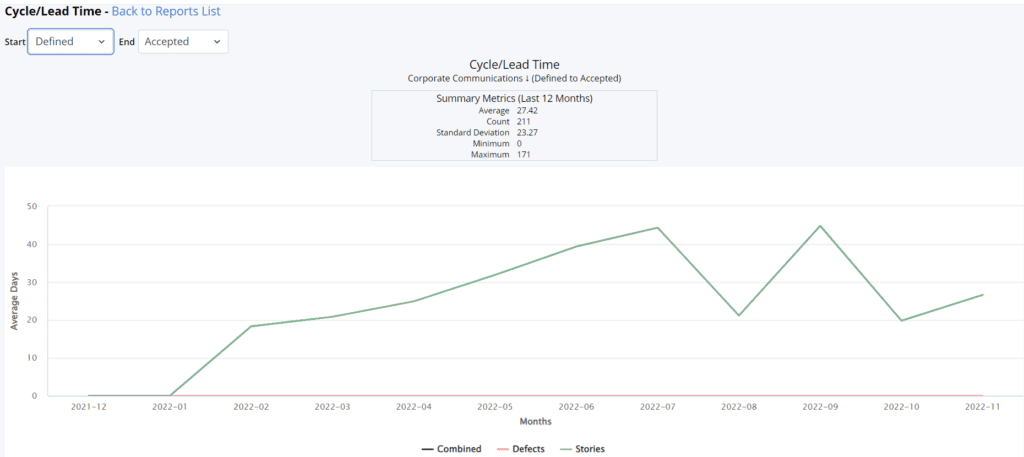
Because dependencies impact the speed at which the team can do their work, Amber would like to start tracking how dependencies impact the team’s flow. Currently, the team uses daily standups and retrospectives to discuss work going through the kanban and when things don’t get finished in an iteration.
Competency
The Corporate Comms team recently completed a Team and Technical Agility assessment.
Amber is reviewing the organization-wide results with the LACE team and discussing how to analyze the results to determine next steps. But she has shared initial results with her team. Corporate Comms identified growths and strengths based on their results and retrospectives.
Growth area
They need to continue to work on their capacity/velocity to help their flow.
Strength area
They are great at collaboration and peer review as a team.
Team formation
Since their formation less than a year ago, the Corporate Comms team has learned a lot about how to work as a shared service for the whole company. They’ve created new outlets of communication and coordination to increase the value they can deliver.
About Amber Lillestolen
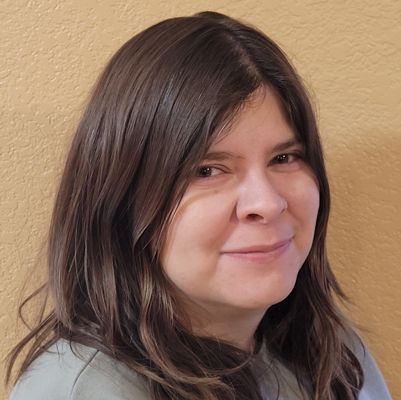
Amber is a Scrum Master at Scaled Agile. For years, she has used empathy and understanding to coach teams to reach their full potential. She enjoys working in a collaborative environment and is passionate about learning. Connect with Amber on LinkedIn.
About Madi Fisher

Madi is an Agile Coach at Scaled Agile. She has many years of experience coaching Agile teams in all phases of their journeys. She is a collaborative facilitator and trainer and leads with joy and humor to drive actionable outcomes. She is a true galvanizer! Connect with Madi on LinkedIn.

